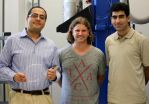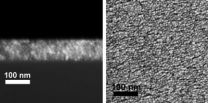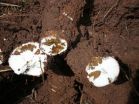(Press-News.org) WINSTON-SALEM, N.C. – August 6, 2012 – When a stroke patient is discharged from the hospital, they often must cope with a new disability or lack of function, so changes in their medications or a new dosing prescription can be particularly confusing. This can lead the patient to overmedicate, take the wrong medication or skip medications entirely and can result in being readmitted to the hospital.
But a pilot study that is looking at a new discharge strategy and being led by researchers at Wake Forest Baptist Medical Center, indicates that phone calls and conversations with a "stroke coach" seem to keep a patient on the road to recovery.
Cheryl D. Bushnell, M.D., associate professor of neurology and director of Wake Forest Baptist's Primary Stroke Center, saw firsthand the need for a better hospital-to-home transition. "Many patients are not only overwhelmed with the new diagnosis of stroke, but also the risk factors that might be uncovered during the stroke hospital stay. This means new medications or adjustments to the old ones. Most important, all of the stroke education we give to people in the hospital before going home may be forgotten with everything else that happens during the hospital stay, so getting some additional teaching after getting home could help this transition."
Bushnell, Wake Forest Baptist neurology colleague Elizabeth Sides, MEd., and colleagues from Duke University School of Medicine, followed stroke patients who were discharged from the hospital with two or more changes in their medications between admission and discharge. Their findings were recently published online in the July 25, 2012 issue of the journal BMC Public Health (http://www.biomedcentral.com/1471-2458/12/549).
The study followed 30 stroke patients who had a change of at least two medications between admission and discharge. The first 20 patients were selected for coach calls and the remaining patients served as a control group and did not receive coaching.
Prior to discharge, the coach reviewed a packet of information with each patient and their caregiver. The information included: specifics about when to call 911 or their physician and/or pharmacist; lifestyle suggestions to prevent stroke; a checklist of the individual patient's risk factors with additional information about each; and a list of their current medications, what they treat and the dosage.
Within two weeks of discharge, each of the 20 study participants received a call from the medication coach who provided general information about stroke and the importance of preventing another stroke, how to mitigate their individual stroke risk factors and the importance of taking their prescribed medications. The medication coach assessed each participant's understanding of their discharge orders by reviewing each stroke prevention medication on the participant's discharge list, asking whether each was still taking the medication, and if not, why. The coach also determined whether the participant understood the purpose of each medication, asking how to take it, refill it, and to identify its side effects. In closing the call, the coach asked participants if they had any specific questions about their medications or stroke recovery.
Following each call, the coach forwarded medication-related questions to a pharmacist and stroke-related questions to a stroke nurse, compiled their responses and called the participant back with the information. These responses were also summarized and sent to the participant's primary care provider. Finally, the coach summarized any lengthy answers, writing at a 7th grade level, and sent them to each participant in a follow-up letter.
At the end of three months, an interviewer contacted all study subjects to hear how participants had fared. Overall, researchers found very little difference between the coaching and control group when it came to knowledge of medications and stroke. However, more participants in the coaching group (93.8 percent) knew what to do if problems or symptoms worsened than the control group (77.8 percent) and a significantly larger number of coaching participants (93.8 percent) had seen their primary care provider since discharge than those in the control group (60 percent). In addition, there were trends toward lower depression severity scores in the intervention group, higher reported health status scores and lesser disability among those in the control group.
While recognizing the limitations of a small study, Wake Forest Baptist researchers believe the overwhelmingly positive feedback from participants about the post-discharge coaching, the feasibility of adding this element to discharge plans, and the early influence on keeping follow-up appointments with their primary care providers show the promise of this type of program.
###Co-authors include Eric D. Peterson, M.D., Louise O. Zimmer, MPH, Leslie Wilson, B.S., and Wenqin Pan, Ph.D., all of Duke Clinical Research Institute, Duke University School of Medicine, and DaiWai M. Olson, Ph.D., Department of Medicine, Division of Neurology, Duke University Medical Center.
Wake Forest Baptist Stroke Center has an ongoing TRAnsition Coaching for Stroke (TRACS) program, which incorporates the medication coaching in this pilot study, but also includes a screening tool to identify patients who are at high risk for worsening problems from the stroke, or are having trouble managing their medications or appointments. Our goal is to improve the transition from hospital to home, and potentially avoid rehospitalization by identifying those who need help before something serious happens.
Competing Interests: Dr. Bushnell receives research salary support from NIH/NINDS K02 NS058760, but this funded research is not related in any way to the study presented in this manuscript. Dr. Peterson received salary support from the Agency for Health Care Research Quality, the funding source for this study. None of the other coauthors have any competing interests to disclose.
Acknowledgements: This project was supported by grant number U18HS016964 from the Agency for Healthcare Research and Quality. The content is solely the responsibility of the authors and does not necessarily represent the official views of the Agency for Healthcare Research and Quality. The authors would like to thank Patricia Frazier, MA for enrolling participants, Judith A Stafford, MS for statistical programming, Charlie Stoner, PharmD, BSN, for triaging pharmacy questions and Bob Sanderford for data entry.
Media Contacts: Paula Faria, pfaria@wakehealth.edu, 336-716-1279; Marguerite Beck, marbeck@wakehealth.edu, 336-716-2415 or the main office number, (336) 716-4587.
Coach could be key in helping stroke patients
2012-08-08
ELSE PRESS RELEASES FROM THIS DATE:
Using millions of years of cell evolution in the fight against cancer
2012-08-08
As the medical community continues to make positive strides in personalized cancer therapy, scientists know some dead ends are unavoidable. Drugs that target specific genes in cancerous cells are effective, but not all proteins are targetable. In fact, it has been estimated that as few as 10 to 15 percent of human proteins are potentially targetable by drugs. For this reason, Georgia Tech researchers are focusing on ways to fight cancer by attacking defective genes before they are able to make proteins.
Professor John McDonald is studying micro RNAs (miRNAs), a class ...
UCF nanoparticle discovery opens door for pharmaceuticals
2012-08-08
What a University of Central Florida student thought was a failed experiment has led to a serendipitous discovery hailed by some scientists as a potential game changer for the mass production of nanoparticles.
Soroush Shabahang, a graduate student in CREOL (The College of Optics & Photonics), made the finding that could ultimately change the way pharmaceuticals are produced and delivered.
The discovery was based on using heat to break up long, thin fibers into tiny, proportionally sized seeds, which have the capability to hold multiple types of materials locked in ...
New drug successfully halts fibrosis in animal model of liver disease
2012-08-08
A study published in the online journal Hepatology reports a potential new NADPH oxidase (NOX) inhibitor therapy for liver fibrosis, a scarring process associated with chronic liver disease that can lead to loss of liver function.
"While numerous studies have now demonstrated that advanced liver fibrosis in patients and in experimental rodent models is reversible, there is currently no effective therapy for patients," said principal investigator David A. Brenner, MD, vice chancellor for Health Sciences and dean of the School of Medicine at the University of California, ...
Chemists advance clear conductive thin films
2012-08-08
PROVIDENCE, R.I. [Brown University] — In a touch-screen display or a solar panel, any conductive overlay had better be clear. Engineers employ transparent thin films of indium tin oxide (ITO) for the job, but a high-tech material's properties are only half its resume. They must also be as cheap and easy to manufacture as possible. In a new study, researchers from Brown University and ATMI Inc. report the best-ever transparency and conductivity performance for an ITO made using a chemical solution, which is potentially the facile, low-cost method manufacturers want.
"Our ...
Diseased trees new source of climate gas
2012-08-08
Diseased trees in forests may be a significant new source of methane that causes climate change, according to researchers at the Yale School of Forestry & Environmental Studies in Geophysical Research Letters.
Sixty trees sampled at Yale Myers Forest in northeastern Connecticut contained concentrations of methane that were as high as 80,000 times ambient levels. Normal air concentrations are less than 2 parts per million, but the Yale researchers found average levels of 15,000 parts per million inside trees.
"These are flammable concentrations," said Kristofer Covey, ...
Researchers demonstrate control of devastating cassava virus in Africa
2012-08-08
ST. LOUIS, MO, August 7, 2012— An international research collaboration recently demonstrated progress in protecting cassava against cassava brown streak disease (CBSD), a serious virus disease, in a confined field trial in Uganda using an RNA interference technology. The field trial was planted in November 2010 following approval by the National Biosafety Committee of Uganda. The plants were harvested in November 2011 and results were published in the August 1, 2012 issue of the journal Molecular Plant Pathology . These results point researchers in the right direction ...
GEN reports on recent progress in Alzheimer's research
2012-08-08
New Rochelle, NY, August 7, 2012—The global market value of Alzheimer's disease therapeutics could soar to the $8 billion range once therapeutics are approved that actually change the course of the disease, reports Genetic Engineering & Biotechnology News (GEN). The current therapeutic market is valued at $3 to $4 billion, shared among drugs that temporarily delay disease progression or address the symptoms but do not alter the underlying disease, according to a recent issue of GEN.
"Despite all the research on amyloid plaques and neurofibrillary tangles there is still ...
Notre Dame researcher is shedding light on how jaws evolve
2012-08-08
If you're looking for information on the evolution and function of jaws, University of Notre Dame researcher Matt Ravosa is your man.
His integrative research program investigates major adaptive and morphological transformations in the mammalian musculoskeletal system during development and across higher-level groups. In mammals, the greater diversification and increasingly central role of the chewing complex in food procurement and processing has drawn considerable attention to the biomechanics and evolution of this system. Being among the most highly mineralized, and ...
Can nature parks save biodiversity?
2012-08-08
The 14 years of wildlife studies in and around Madagascar's Ranomafana National Park by Sarah Karpanty, associate professor of wildlife conservation at Virginia Tech's College of Natural Resources and Environment, and her students are summarily part of a paper on biodiversity published July 25 by Nature's Advanced Online Publication and coming out soon in print.
As human activities put increasing pressures on natural systems and wildlife to survive, 200 scientists around the world carved up pieces of the puzzle to present a clearer picture of reality and find ways to mitigate ...
Planting the seeds of defense
2012-08-08
LA JOLLA, CA----It was long thought that methylation, a crucial part of normal organism development, was a static modification of DNA that could not be altered by environmental conditions. New findings by researchers at the Salk Institute for Biological Studies, however, suggest that the DNA of organisms exposed to stress undergo changes in DNA methylation patterns that alter how genes are regulated.
The scientists found that exposure to a pathogenic bacteria caused widespread changes in a plant's epigenetic code, an extra layer of biochemical instructions in DNA that ...




